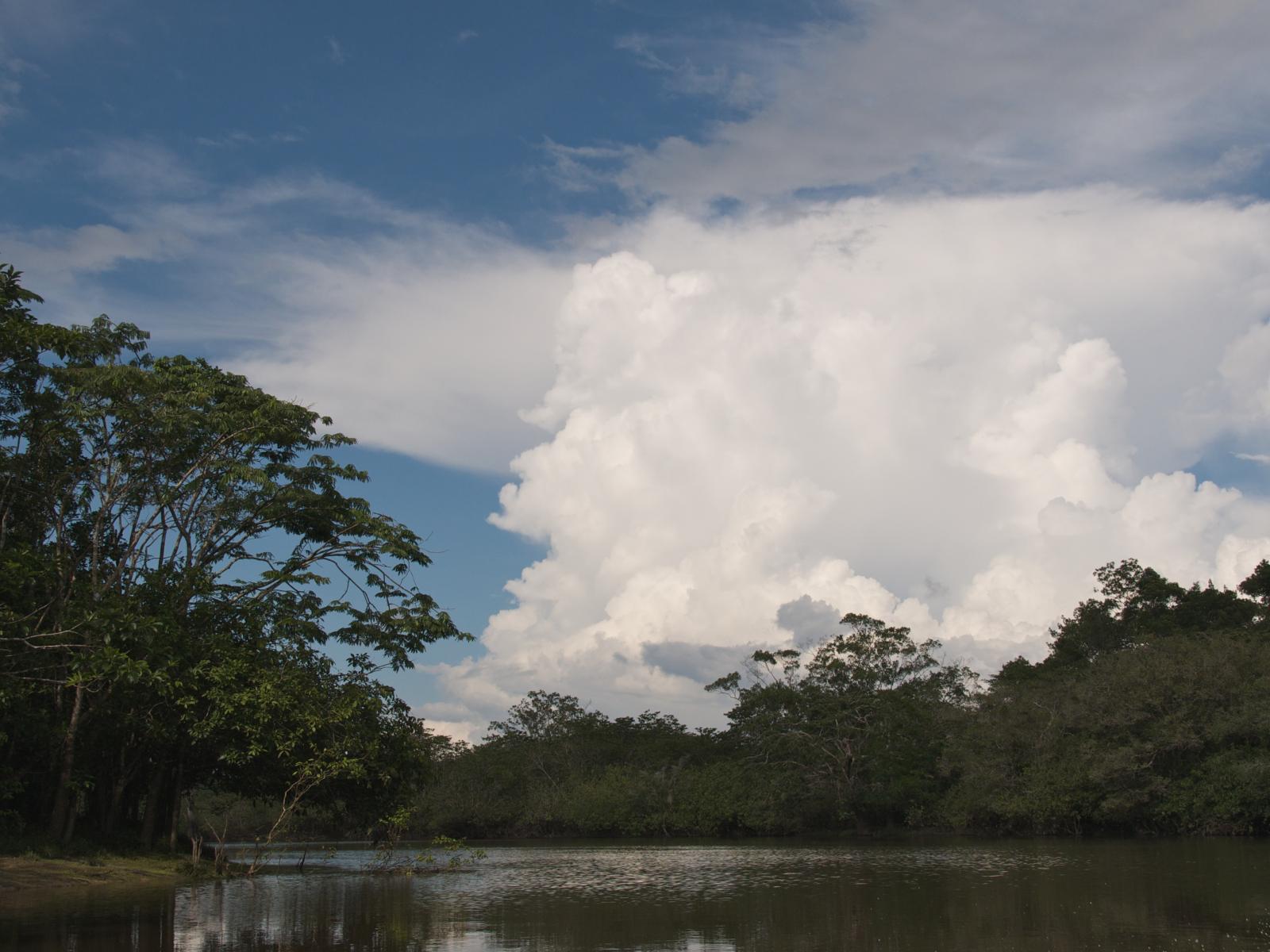In-Plant Biochemistry Governs High Altitude Fine Particles over the Amazon
Combining aircraft measurements and regional modeling to identify role of in-plant biochemistry in secondary organic aerosol formation

Updrafts transport plant emissions higher into the atmosphere where they convert to aerosol particles.
The Science
Fine particles in the atmosphere seed clouds and limit the solar energy that reaches Earth. Over the Amazon rainforest, oxidation of organic gases, like isoprene emitted by plants, forms fine particles known as secondary organic aerosol (SOA). Isoprene epoxydiol SOA (IEPOX-SOA) is a key component of these SOA particles. Traditionally, researchers thought it formed by multiphase atmospheric chemistry in the gas-phase, particle-phase, and clouds. However, new research shows that these atmospheric chemistry pathways do not occur at 10-14 km altitudes and cannot explain IEPOX-SOA observed by the aircraft at high altitudes. Gases formed by in-plant biochemistry and/or oxidation of deposited IEPOX gases on the surfaces of leaves/soils are transported high by cloud updrafts where they condense at cold temperatures (~ negative 50 degrees C) to form IEPOX-SOA.
The Impact
For the first time, researchers show that in-plant biochemistry plays a central, but previously unrecognized, role in IEPOX-SOA formation and atmosphere-biosphere-climate interactions throughout the Amazon rainforest. These processes are not considered in current air quality and climate models. This potentially groundbreaking work will open new frontiers studying the role of surface and in-plant biochemistry in aerosol forming processes. It will also impact the predictability of Earth system models in simulating aerosols and their interactions with clouds.
Summary
Combining unique high-altitude aircraft measurements, laboratory-based process modeling, and detailed regional model simulations, researchers show that in-plant biochemistry plays a central but previously unidentified role in fine particulate-forming processes and atmosphere–biosphere–climate interactions over the Amazon rainforest. IEPOX-SOA are key components of small aerosol particle mass throughout the atmospheric column over the Amazon rainforest and are traditionally thought to form by multiphase chemical pathways. For the first time, researchers showed that these pathways are strongly inhibited by the solid phase of aerosol particles and lack of cloud liquid water in the cold and dry regions of the upper troposphere. Using detailed regional model simulations, researchers found that using traditional multiphase chemistry underpredicts the IEPOX-SOA observed by aircraft at high altitudes by more than an order of magnitude. Incorporating newly discovered processes related to the release of 2-methyltetrol gases formed by in-plant biochemistry on the surfaces of soils and leaves, their transport by clouds to the upper troposphere, and condensation to particles closed the large model-measurement gaps and helped explain the aircraft measurements of IEPOX-SOA in the upper troposphere. The results provide compelling evidence for new pathways related to land surface–aerosol–cloud interactions that have not been previously considered.
The research uses data from the Department of Energy G-1 aircraft and the German HALO aircraft during Green Ocean Amazon (GoAmazon) 2014/5 field campaign for model development and evaluation of IEPOX-SOA over the Amazon rainforest. Computational resources at EMSL, the Environmental Molecular Sciences Laboratory, a DOE Office of Science user facility at Pacific Northwest National Laboratory, were used for the simulations.
PNNL Contact
Manish Shrivastava, Pacific Northwest National Laboratory, manishkumar.shrivastava@pnnl.gov
Funding
This research is supported by the Department of Energy Office of Science, Biological and Environmental Research program through the Early Career Research Program and the Atmospheric System Research Program.
Published: March 21, 2022
Shrivastava, M., Rasool, Q. Z., Zhao, B., Octaviani, M., Zaveri, R. A., Zelenyuk, A., Gaudet, B., Liu Y., Shilling J.E., Schenider J., Schulz C., Zöger M., Martin S.T., Ye J., Guenther A., Souza R.F., Wendisch M., Pöschl, U. “Tight Coupling of Surface and In-Plant Biochemistry and Convection Governs Key Fine Particulate Components over the Amazon Rainforest.” ACS Earth and Space Chemistry, 6, 380, (2022). doi.org/10.1021/acsearthspacechem.1c00356